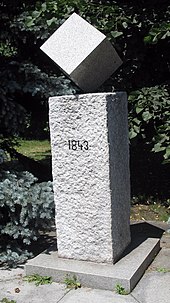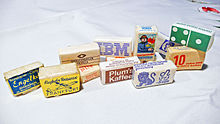Lump sugar
Sugar Cube (also lump of sugar) is humidified to small mostly square-shaped portions squeezed and then dried granulated sugar .
Lump sugar is sold in different forms and with different types of sugar. In addition to the common sugar cubes made from white granulated sugar, there is also sugar cubes made from brown beet and cane sugar. The shape can also vary - in addition to the cubes, pieces of sugar in the form of clover leaves, hearts, playing card symbols and other shapes are produced. As a cube sugars in general, all comparable in cuboid or other forms Size pressed products are referred to.
history

Lump sugar was sold by the trade as an alternative to the similarly manufactured sugar breads and sugar loafs that were common up until the 19th century . The latter were large pieces of cone-shaped granulated sugar that were rock-hard after the sugar mass had dried. Such a sugar loaf came on the market in sizes up to 1.50 m high and was expensive. If sugar was needed in the household, for example for a coffee party , smaller pieces had to be removed from this cone. To do this, you had to use various tools: A sugar hammer, a sugar hoe or a sugar breaker were used.
Jacob Christoph Rad is considered the inventor of the sugar lump . He was the manager of a sugar refinery in the Moravian Datschitz (Czech. Dačice ). For the production, Rad created a model from sheet metal strips that resembled a current bowl for ice cubes , and for which he received a patent in 1843. The wet sugar was poured into the model and dried; then the sugar cubes could be removed. Rad's wife Juliane had the idea of making suitable small pieces instead of the unwieldy carrot or sugar loaf after she was injured on a sugar breaker while serving.
In 1875, the Frenchman Eugène François invented a machine to crush pieces of sugar into cubes. Around 1900, the Belgian Théophile Adant poured the sugar magma before crystallization into plates, which were then sawn into bars or cubes (Adant process). This production route was the standard route for sugar lump production until the 1940s. In 1949, the Frenchman Louis Chambon developed a rotary machine in which sugar crystals are pressed into cubes (chambon process). This technique of pressing caster sugar, usually moist, finely crystalline sugar, into cubes or other forms, has since been the usual process in various forms (Höveler, Elba, Chamdon and Vibro process) for the industrial production of sugar cubes .
packaging
In Germany, Karl Hellmann, ancestor of Hellma GmbH for single-portion sugar in Nuremberg, began packing sugar cubes in duplicate in 1923. These two-packs were widespread until the 1990s and were served with coffee in cafes, restaurants, hotels, etc. The packs were printed with information about the catering establishment or the type of coffee, or they showed company advertising, astrological, neutral patterns or - less often - political statements (see examples). In the meantime, this type of administration has become rarer, and sachets with loose sugar have become more and more popular. In cafes in the higher price range you can still often find lump sugar in a sugar bowl with enclosed sugar tongs .
literature
- Harry Kaysers, Hubert Schweck, Hans-Joachim Delavier: Special crystal sugar products. Cube sugar, nib sugar and loaf sugar. In: Pieter van der Poel, Hubert M. Schieweck, Thomas K. Schwartz: Sugar Technology. Beet and Sugar Cane Manufacture. Publishing house Dr. Albert Bartens KG, Berlin 1998, ISBN 3-87040-065-X , pp. 962-964.
- Entry sugar . In: Meyers Enzyklopädisches Lexikon . Volume 25. Bibliographisches Institut, Lexikonverlag, Mannheim / Vienna / Zurich 1975, p. 778.
- Wener Kohl: A front Austrian invents the lump sugar in The Austrian Sugar Industry and its History (s) 1750-2013 , pp. 97 ff. Böhlau-Verlag, ISBN 978-3-205-79498-1
Web links
Individual evidence
- ↑ Jana Bisová: The eunuches of Worms in Bohemia and Moravia . In: Kurt Andermann (Hrsg.): Ritteradel in the Old Kingdom. Die Kämmerer von Worms called von Dalberg = work of the Hessian Historical Commission NF Bd. 31. Hessische Historical Commission, Darmstadt 2009. ISBN 978-3-88443-054-5 , pp. 289-316 (300).
- ^ BR Bayern 2, Das Kalenderblatt , January 23, 2013, patent on the sugar cubes; https://www.br.de/radio/bayern2/sendung/kalenderblatt/2301-wuerfelzucker-patent-rad-100.html
- ^ A b Harry Kaysers, Hubert Schweck, Hans-Joachim Delavier: Special crystal sugar products. Cube sugar, nib sugar and loaf sugar. In: Pieter van der Poel, Hubert M. Schieweck, Thomas K. Schwartz: Sugar Technology. Beet and Sugar Cane Manufacture. Publishing house Dr. Albert Bartens KG, Berlin 1998, ISBN 3-87040-065-X , pp. 962-964.
- ↑ Who invented the sugar cube? In: Basler Zeitung . December 21, 2009, archived from the original on May 5, 2010 ; Retrieved December 2, 2010 .
- ↑ Le sucre en morceau. Presentation on www.lesucre.com.
- ↑ Sebastian Kirschner: The die is cast, Süddeutsche Zeitung Magazin, March 2nd, 2016. Accessed on May 19, 2018 .


